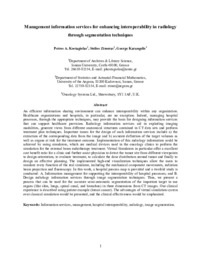| dc.contributor.author | Κωσταγιόλας, Πέτρος | el_GR |
| dc.contributor.author | Ζημέρας, Στέλιος | el_GR |
| dc.contributor.author | Karangelis, George | en |
| dc.contributor.author | Zimeras, Stelios | en |
| dc.contributor.author | Kostagiolas, Petros | en |
| dc.coverage.spatial | GR | en |
| dc.date.available | 2010-07-19T12:00:00Z | el_GR |
| dc.date.issued | 2007 | el_GR |
| dc.identifier.uri | http://hdl.handle.net/10797/12492 | |
| dc.description | Περιέχει το πλήρες κείμενο | el_GR |
| dc.description.abstract | An efficient information sharing environment can enhance interoperability within any organization. Healthcare organizations and hospitals, in particular, are no exception. Indeed, managing hospital processes, through the appropriate techniques, may provide the basis for designing information services that can support healthcare provision. Radiology information services aid in exploding imaging modalities, generate views from different anatomical structures contained in CT data sets and perform treatment plan techniques. Important issues for the design of such information services include a) the extraction of the corresponding data from the image and b) accurate definition of the target volumes as well as organs at risk for the treatment outcome. Implementation of this radiology information could be achieved by using simulators, which are medical devices used in the oncology clinics to perform the simulation for the external beam radiotherapy treatment. Virtual Simulators in particular offer a excellent cost benefit ratio for a clinic and further assist physician to detect the tumor site from different viewpoints to design orientation, to evaluate treatment, to calculate the dose distribution around tumor and finally to design an effective planning. The implemented high-end visualization techniques allow the users to simulate every function of the real simulator, including the mechanical component movements, radiation beam projection and fluoroscopy. In this work, a hospital process map is provided and a twofold study is conducted: A. Information management for supporting the interoperability of hospital processes; and B. Design radiology information services through image segmentation techniques. Thus, we present a process that can be used for the accurate semi-automatic segmentation of the important target in use organs (like skin, lungs, spinal canal, and bronchus) in three dimensions from CT images. Our clinical experience is described using patient example (breast cancer). The advantages of virtual simulation system over classical simulation would be presented, and the clinical effectiveness would be emphasized. | en |
| dc.language.iso | eng | en |
| dc.source | eJETA - The electronic Journal on E-Commerce Tools and Applications, 2007, vol. 2, n. 2. | en |
| dc.title | Management Information Services for Enhancing Interoperability in Radiology through Segmentation Techniques | en |
| dc.type | Article | en |
| dc.subject.uncontrolledterm | Information services | en |
| dc.subject.uncontrolledterm | Management | en |
| dc.subject.uncontrolledterm | Hospital Interoperability | en |
| dc.subject.uncontrolledterm | Radiology | en |
| dc.subject.uncontrolledterm | Image segmentation | en |
| dc.subject.JITA | Τεχνολογίες πληροφόρησης και τεχνολογίες βιβλιοθηκών | el_GR |
| dc.subject.JITA | Information technology and library technology | en |
| dc.identifier.JITA | LZ | en |
